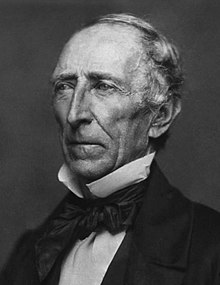John Tyler
| John Tyler | |
|---|---|
 |
|
| 10th President of the United States | |
|
In office April 4, 1841 – March 4, 1845 |
|
| Vice President | None |
| Preceded by | William Henry Harrison |
| Succeeded by | James K. Polk |
| 10th Vice President of the United States | |
|
In office March 4, 1841 – April 4, 1841 |
|
| President | William Henry Harrison |
| Preceded by | Richard Mentor Johnson |
| Succeeded by | George M. Dallas |
|
United States Senator from Virginia |
|
|
In office March 4, 1827 – February 29, 1836 |
|
| Preceded by | John Randolph |
| Succeeded by | William Cabell Rives |
| President pro tempore of the U.S. Senate | |
|
In office March 3, 1835 – December 6, 1835 |
|
| Preceded by | George Poindexter |
| Succeeded by | William R. King |
| 23rd Governor of Virginia | |
|
In office December 10, 1825 – March 4, 1827 |
|
| Preceded by | James Pleasants |
| Succeeded by | William Branch Giles |
| Member of the U.S. House of Representatives from Virginia's 23rd district |
|
|
In office December 17, 1816 – March 3, 1821 |
|
| Preceded by | John Clopton |
| Succeeded by | Andrew Stevenson |
| Personal details | |
| Born |
March 29, 1790 Charles City County, Virginia, U.S. |
| Died | January 18, 1862 (aged 71) Richmond, Virginia, C.S. |
| Resting place |
Hollywood Cemetery Richmond, Virginia, U.S. |
| Political party |
Democratic-Republican (1811–1828) Democratic (1828–1834) Whig (1834–1841) None (1841–1862) |
| Spouse(s) |
|
| Children | 15, including Robert, David Gardiner, John Alexander, and Lyon Gardiner |
| Alma mater | College of William and Mary |
| Profession | Lawyer |
| Signature | |
| Military service | |
| Allegiance |
|
| Service/branch | Charles City Rifles (Virginia militia company) |
| Years of service | 1813 |
| Rank | Captain |
| The Tyler Cabinet | ||
|---|---|---|
| Office | Name | Term |
| President | John Tyler | 1841–1845 |
| Vice President | None | 1841–1845 |
| Secretary of State | Daniel Webster (W) | 1841–1843 |
| Abel P. Upshur (W) | 1843–1844 | |
| John C. Calhoun (D) | 1844–1845 | |
| Secretary of Treasury | Thomas Ewing, Sr. (W) | 1841 |
| Walter Forward (W) | 1841–1843 | |
| John C. Spencer (W) | 1843–1844 | |
| George M. Bibb (D) | 1844–1845 | |
| Secretary of War | John Bell (W) | 1841 |
| John C. Spencer (W) | 1841–1843 | |
| James M. Porter (W) | 1843–1844 | |
| William Wilkins (D) | 1844–1845 | |
| Attorney General | John J. Crittenden (W) | 1841 |
| Hugh S. Legaré (D) | 1841–1843 | |
| John Nelson (W) | 1843–1845 | |
| Postmaster General | Francis Granger (W) | 1841 |
| Charles A. Wickliffe (W) | 1841–1845 | |
| Secretary of the Navy | George E. Badger (W) | 1841 |
| Abel P. Upshur (W) | 1841–1843 | |
| David Henshaw (D) | 1843–1844 | |
| Thomas W. Gilmer (D) | 1844 | |
| John Y. Mason (D) | 1844–1845 | |
| Judicial Appointments | ||
|---|---|---|
| Court | Name | Term |
| U.S.S.C. | Samuel Nelson | 1845–1872 |
| E.D.Va. | James D. Halyburton | 1844–1861 |
| D. Ind. | Elisha M. Huntington | 1842–1862 |
|
E.D.La. W.D.La. |
Theodore H. McCaleb | 1841–1861 |
| D.Vt. | Samuel Prentiss | 1842–1857 |
| E.D.Pa. | Archibald Randall | 1842–1846 |
| D.Mass. | Peleg Sprague | 1841–1865 |
John Tyler (March 29, 1790 – January 18, 1862) was the tenth President of the United States (1841–45). He was also, briefly, the tenth Vice President (1841), elected to that office on the 1840 Whig ticket with William Henry Harrison. Tyler became president after Harrison's death in April 1841, only a month after the start of the new administration. Known to that point as a supporter of states' rights, which endeared him to his fellow Virginians, his actions as president showed that he was willing to back nationalist policies as long as they did not infringe on the powers of the states. Still, the circumstances of his unexpected rise to the presidency, and its threat to the presidential ambitions of Henry Clay and other politicians, left him estranged from both major parties. A firm believer in manifest destiny, President Tyler sought to strengthen and preserve the Union through territorial expansion, most notably the annexation of the independent Republic of Texas in his last days in office.
Tyler, born to an eminent Virginia family, came to national prominence at a time of political upheaval. In the 1820s the nation's only political party, the Democratic-Republicans, split into factions. Though initially a Democrat, his opposition to Andrew Jackson and Martin Van Buren led him to ally with the Whig Party. Tyler served as a Virginia state legislator, governor, U.S. representative, and U.S. senator before his election as vice president in the presidential election of 1840. He was put on the ticket to attract states' rights Southerners to what was then a Whig coalition to defeat Van Buren's re-election bid.
...
Wikipedia
